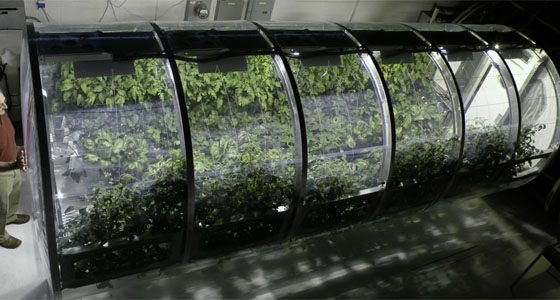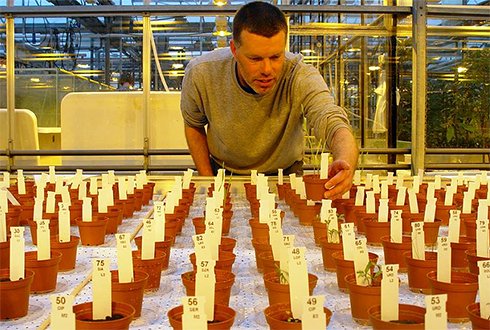April 28, 2014 – Wageningen University in the Netherlands has undertaken a pilot project to test the viability of Martian soil for growing plants. It has done this on behalf of the Mars One Project, aimed at putting four colonists on the Red Planet by 2024, a decade away.
For soil, NASA has provided the medium made from earth collected in Hawaii on the edge of volcanoes. The plants so far have thrived because we know the Hawaiian and Martian soils are similar containing phosphorus, iron and nitrogen. The experiment involved 14 different plant species over 50 days. The plants germinated and grew. Some even blossomed. So we know the soil is a suitable medium.
But it is what the pilot project cannot tell us that concerns anyone who would consider hopping on a one-way voyage to Mars. Here is a list of Mars challenges that any agricultural enterprise will have to address:
- Mars is a low-gravity environment compared to Earth. We don’t know what impact that may have on plant development.The experiment at Wageningen doesn’t address this.
- The Mars surface is not shielded from cosmic rays like Earth. What will cosmic rays do to plant development? Wageningen doesn’t address this either.
- The thin atmosphere of Mars although almost all CO2 and one would think, therefore, plant friendly, is not dense enough to retain much heat, resembling more Antarctica than any other place on Earth. We know not much of anything can grow there unless contained with artificial lighting.
- Water is not free flowing on Mars today although billions of years ago it was. Any water exposed to the surface has little chance of remaining in that state for very long. In addition the low gravity changes the nature of the way water flows.
- Solar energy reaching the surface of Mars is a fraction of that which plants get here on Earth. So did Waginingen test plant species more suitable for lower lighting environments and if so were any of these crop-bearing?
- The Martian atmosphere is tenuous, equivalent to that found here on Earth at elevations of 30,000 meters (approximately 100,000 feet). Atmospheric pressure at that height is 1,034 pascales (0.15 pounds per square inch.) Nothing here on Earth lives in atmospheric conditions like this.
- There are no natural pollinators that we can easily bring to Mars to ensure that plants can propagate. Without bees and other insects how would plants reproduce?
So how do we overcome these challenges?
- On the International Space Station (ISS) there are experiments growing plants in micro-gravity conditions. So far the results are acceptable. And in this latest Dragon capsule delivery a vegetable garden has been added to the ISS. If it proves successful we then know that micro-gravity is no impediment. So does that mean the low gravity environment in Mars may not be as serious an issue of concern? Probably.
- The cosmic rays exposure, however, is and the way to deal with it is through growing plants in sufficiently shielded containment buildings on the surface or under the surface of the planet.
- To combat the thin atmosphere plants grown on Mars will be contained in pressurized closed-system environments like the experimental prototype lunar greenhouse, built by University of Arizona, seen in the image below.
- Closed-system environments also helps solve the water management issue on Mars. Finding local water remains a bit of an unknown although there is strong evidence of potential subsurface water in the form of permafrost, as well as water ice at the Martian poles. Harvesting Martian water for humans and plants is critical. Getting the water to where it’s needed will require the outfitting of any Martain grow-op with pumps and irrigation tubes. These systems will require a steady power supply.
- To combat reduced solar energy any Martian greenhouse will supplement sunlight with grow lights designed to deliver the right lighting spectrum to optimize plant growth.
- Closed-system environments will also combat the minimal Martian atmosphere as well as the variable temperatures the planet surface experiences.
- And finally, if we cannot bring insects to Mars to help us pollinate plants then we need to emulate them. This can be accomplished through microbots and nanobots that mimic what insects do with no down side. None will eat the crops.
It is clear that the life support systems needed on Mars will not only support a breathable environment for the colonists but also that for the plants as well. Today, however, we are more than a decade away from achieving such workable closed-system environments to test in near-Earth space, let alone on the Moon or Mars.
Our experiences here on Earth in places like Biosphere 2 have shown us just how challenging it is to build an ecologically-balanced bio-regenerative system. Biosphere 2 failed here on Earth but at least when it went wrong those inside were able to open a door and leave. That opportunity will not be one to which Mars One colonists can avail themselves. And consider that the ambitious departure date for the first Mars One colonists is tentatively set for 2024 with arrival on the planet early in 2025, even the researchers at Wageningen admit a decade may not be enough time to perfect reliable life support systems that can grow food to sustain human settlement.















